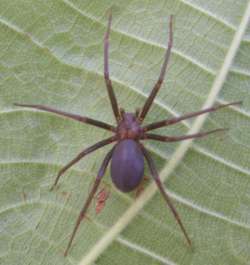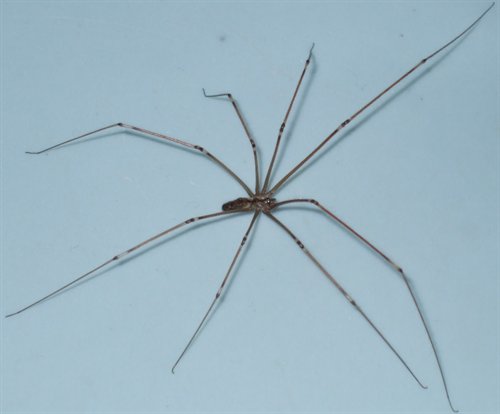| As aranhas possuem
apenas dois segmentos corporais (ao contrário dos insectos, que
possuem três): o cefalotórax, ou prosoma, (resultado do tórax
fundido com a cabeça) e o abdómen chamado de opistosoma.
As aranhas possuem oito pernas
(enquanto que os insectos possuem seis) e os seus olhos são lentes
únicas, em vez de lentes compostas. Elas podem ter 8, 6, 4, 2 ou
mesmo nenhum olho, como no caso de algumas aranhas
cavernícolas.
Há vários tipos de aranhas, as
venenosas e aquelas que "saltam" querendo se proteger.
O waypoint inicial serve apenas para
indicar o acesso ao local da cache. Como recompensa por estar a ler
o texto da página indico-lhe já como chegar às coordenadas finais:
Some à longitude duzentos e cinquenta e quatro milésimas. Subtraia
da latitude treze milésimas.
Ao contrário do que muitos pensam,
as aranhas não são insectos.
Juntamente com os escorpiões, os carrapatos e os ácaros, as
aranhas pertencem à classe dos Arachnida, ao filo dos artrópodes e
subfilo Chelicerata, que inclui, além dos aracnídeos, a classe dos
insectos, dos crustáceos e outras.
As teias de uma aranha são 5 vezes
mais fortes do que o aço no mesmo diâmetro. Além disso a teia
pode ainda se esticar mais 40% que o seu comprimento inicial.
As teias resistem a água e a temperaturas até -45ºC sem se
romperem. A aranha poderia morrer presa em sua própria teia, mas as
suas patas são equipadas com pêlos que não permitem que isso
aconteça

Embora existam 35.000 espécies de
aranhas, alguns estudiosos calculam até 100.000 espécies de
aranhas. Essas 35.000 espécies são divididas em mais de 100
famílias, sendo que apenas 20 a 30 espécies são consideradas
perigosas para o homem. |
Spiders own eight
legs, against six in the insects and unlike insects, have only two
body segments (tagmata) instead of three: a fused head and thorax
(called a cephalothorax or prosoma) and an abdomen (called the
opisthosoma).
Spiders usually have eight eyes in
various arrangements, a fact that is used to aid in taxonomically
classifying different species. Most species of the Haplogynae have
six eyes, although some have eight (Plectreuridae), four (eg.,
Tetrablemma) or even two (most Caponiidae) eyes. Sometimes one pair
of eyes is better developed than the rest, or even, in some cave
species, there are no eyes at all. Several families of hunting
spiders, such as jumping spiders and wolf spiders, have fair to
excellent vision. The main pair of eyes in jumping spiders even see
in colour.
The initial waypoint is only to show the access
road to the cache. As reward for reading the cache page I'm letting
you know how to reach the final coordinates: Add to the longitude
two hundred and fifty four millesimal. Remove thirteen millesimal
from the latitude.

Against what many think spiders aren't
insects. Along with scorpions, whip scorpions, mites, ticks, and
opiliones (harvestmen), spiders belong to the Arachnids class,
Arthropoda phylum and Chelicerata subphylum
that includes besides arachnids, the insects class and
horseshoe crabs.
Spider silk is a remarkably strong
material. Its tensile strength is superior to that of high-grade
steel, and as strong as Aramid filaments, such as Twaron or Kevlar.
Most importantly, spider silk is extremely lightweight: a strand of
spider silk long enough to circle the earth would weigh less than
16 ounces (450 g).
Spider silk is also especially ductile,
able to stretch up to 40% of its length without breaking. This
gives it a very high toughness (or work to fracture), which "equals
that of commercial polyaramid (aromatic nylon) filaments, which
themselves are benchmarks of modern polymer fibber
technology."
Almost 40,000 species of spiders (order
Araneae) have been identified and are currently grouped into
111 families by arachnologists, but because of difficulties in
collecting these often very minute and evasive animals, and because
of many specimens stored in collections waiting to be described and
classified, it is believed that up to 200,000 species may
exist. |